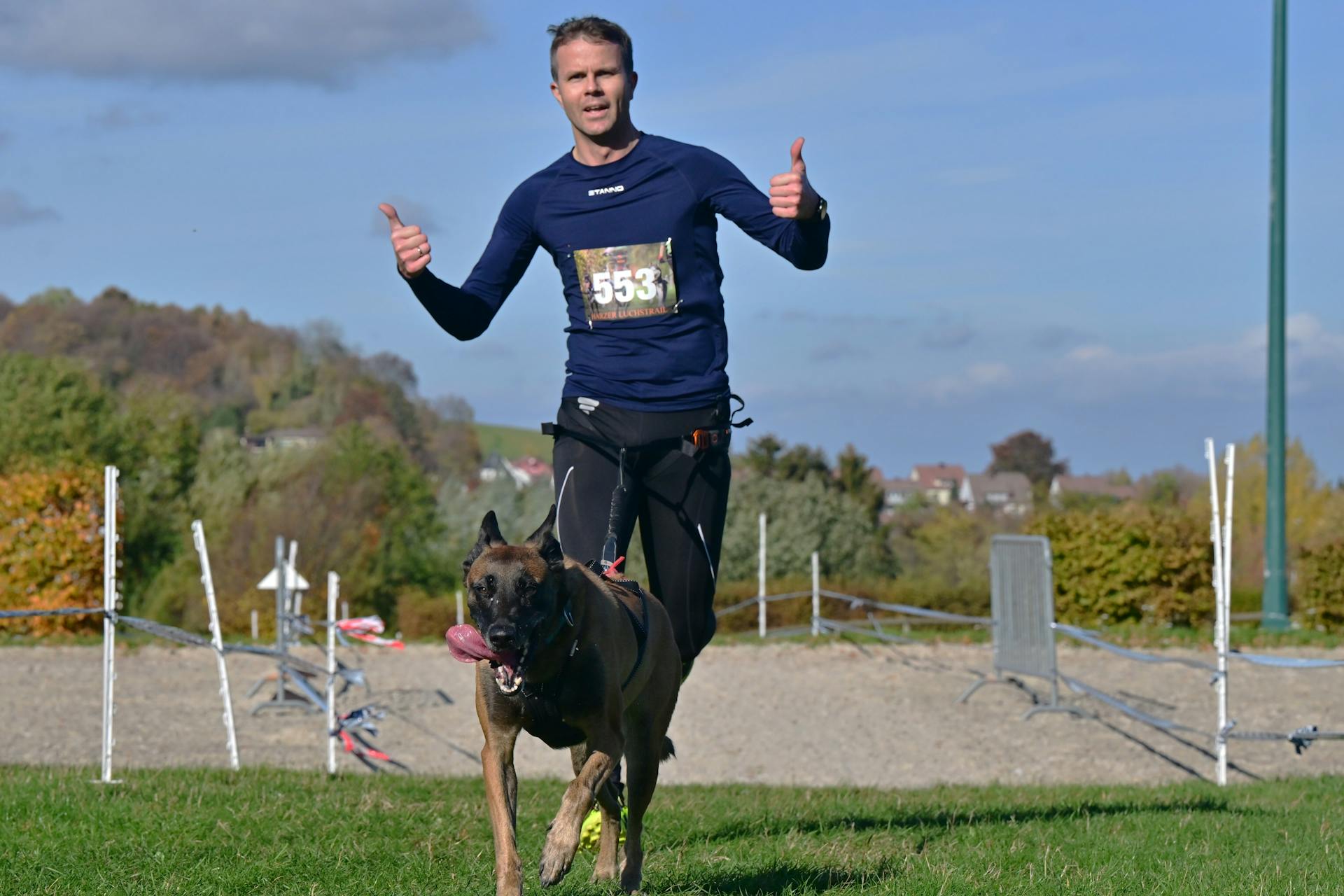
Dog mammary tumors are a common health issue that affects many female dogs.
Some breeds, such as German Shepherds, Golden Retrievers, and Labradors, are more prone to developing these tumors.
Mammary tumors can be benign or malignant, and their growth rate can vary greatly.
A benign tumor is non-cancerous and usually doesn't spread to other parts of the body.
A different take: Benign Types of Dog Tumors
What Are Dog Mammary Tumors?
Mammary tumors in dogs are a type of abnormal cell growth in the breast tissue, commonly associated with breast cancer in female dogs.
The highest incidence of mammary tumors occurs in dogs between 8 to 11 years old.
There are three common types of mammary tumors: adenomas, adenocarcinomas, and carcinomas.
Adenomas are non-cancerous, while adenocarcinomas and carcinomas are malignant.
About 50% of all mammary tumors found will be cancerous.
Mammary tumors are often found by chance, either by the owner during regular petting or grooming, or by a vet during a regular check-up.
The least common kind of malignant tumor found is an inflammatory mammary carcinoma, which is highly malignant and often the most painful of the carcinomas.
Inflammatory carcinomas make up less than 5% of all mammary tumors.
See what others are reading: Types of Dog Tumors with Pictures
Identifying and Treating Dog Mammary Tumors
The most common clinical sign of a malignant mammary tumor is one or more palpable masses underneath the skin of the abdomen. These masses can be firm and nodular, and may be next to or within the nipple and follow along the mammary chain.
Your veterinarian will perform a physical exam to identify the tumor, and may also perform basic blood work and a fine needle aspirate to collect cells for analysis. A biopsy may also be recommended to send out for further diagnosis.
If the tumor has metastasized to other areas of the body, other signs may become evident, including general unwellness, loss of appetite, lack of energy, and weight loss. If the lungs are involved, your dog may have problems with breathing or develop a cough.
Surgery is the best treatment for a majority of mammary tumors, and if there is only one small tumor, under 3cm, and no evidence of spread, surgery can be all that is needed to treat it. Dogs who have multiple tumors may need to have all of the associated glands removed, or in some cases all glands removed.
Radiation therapy is not a commonly used treatment, but it can be helpful as a preoperative irradiation on large tumors or a postoperative irradiation of completely removed tumors.
Intriguing read: Lifespan of Dog with Adrenal Tumor
Identifying Clinical Signs of Dog Tumors
If your dog has a malignant mammary tumor, the most common clinical sign is a palpable mass underneath the skin of the abdomen, often next to or within the nipple and following along the mammary chain.
These masses are usually firm and nodular, and their size and appearance may vary. In some cases, the skin over the mass may ulcerate and bleed, and the affected area may feel warm to the touch and become painful.
If the tumor has metastasized, other signs may become evident, including general unwellness, loss of appetite, lethargy, and weight loss.
In some cases, dogs may develop multiple tumors, or even one that has a history of mammary tumors, which can be benign or malignant.
Some dogs may experience tenderness, warmth, or pain at the location of the tumor, lethargy, decreased appetite and weight loss, and weakness.
If you notice any of these symptoms, it's essential to have your dog examined by a veterinarian immediately.
Here are some common clinical signs of dog tumors:
- Palpable masses underneath the skin of the abdomen
- Firm and nodular masses
- Ulceration and bleeding of the skin over the mass
- Warmth and pain at the affected area
- General unwellness
- Loss of appetite
- Lethargy
- Weight loss
- Tenderness, warmth, or pain at the location of the tumor
- Weakness
Tumor Treatment
Surgery is the best treatment for most dog mammary tumors. If there's only one small tumor, under 3cm, and no evidence of spread, surgery can be all that's needed to treat it.
For dogs with multiple tumors, all associated glands may need to be removed. Your veterinarian will discuss the best options for your dog's situation.
If your dog is intact, an ovariohysterectomy (spaying) is recommended, and may be done at the same time as mammary gland removal. This can have a great impact on the likelihood of a tumor returning in the same area.
Chemotherapy is typically recommended for dogs with larger tumors or evidence of spread to other areas of the body. Radiation therapy may also provide some benefit for dogs with inflammatory carcinomas.
Radiation therapy is not commonly used, but can be helpful as a preoperative irradiation on large tumors or a postoperative irradiation of completely removed tumors. It can also be used as palliative care for inoperable tumors.
Unfortunately, inflammatory carcinomas are highly aggressive and have no currently effective treatment available. The prognosis for this type of cancer is very poor, ranging from weeks to months.
Readers also liked: Best Food for Gassy Dogs
Veterinary Diagnosis and Treatment
Your veterinarian will perform a physical exam to diagnose mammary gland tumors in dogs, which can easily be palpated or touched.
A physical exam can often distinguish between benign and malignant tumors, with malignant tumors feeling stuck to underlying tissues and having indistinct borders.
Your veterinarian may also perform basic blood work and a fine needle aspirate to collect cells for analysis.
A biopsy, or removal of skin/mass tissue, may be done to send out for further diagnosis.
Chest radiographs and an abdominal ultrasound are recommended as follow-ups if the results show cancer, since most mammary tumors spread to the local lymph nodes, chest, and possibly the liver.
Surgery is the best treatment for a majority of mammary tumors, especially if the tumor is small and there is no evidence of spread.
Chemotherapy may be recommended after surgery to maintain health and defend against cancer development in other parts of the body.
Radiation therapy is not commonly used, but can be helpful as a preoperative irradiation on large tumors or postoperative irradiation of completely removed tumors.
A fresh viewpoint: Types of Dog Cancer Pictures
What Causes Tumors?
Tumors can be a scary thing for pet owners to deal with, but understanding what causes them can help us take preventative measures. Hormones play a big role in tumor development.
Mammary tumors in dogs are often linked to hormones, and the type of hormone can determine whether the tumor is benign or malignant.
Male dogs are rarely affected by mammary tumors, which is good news for our furry male friends.
The timing of spaying can also impact a dog's risk of developing a mammary tumor. Dogs spayed before their first heat, around 6 months of age, have a very low risk, typically around 0.5%.
Dogs spayed after their first heat have a much higher risk, with a chance of around 8% for those spayed after their first heat.
Suggestion: Male Dog Humps Female Dog
Veterinarians Diagnose Tumors
Veterinarians diagnose mammary gland tumors in dogs through a physical exam, where they can easily feel the mass by palpation.
A veterinarian may perform basic blood work and a fine needle aspirate, which involves inserting a needle into the mass to collect cells for analysis.
The fine needle aspirate is often done on an outpatient basis in a hospital setting, but it does have some limitations.
A biopsy may be recommended to remove skin or mass tissue for further diagnosis.
Chest radiographs and an abdominal ultrasound may be ordered as follow-up tests if the results show cancer, since most mammary tumors spread to the local lymph nodes, chest, and possibly the liver.
Tumors that are large, have spread to other organs, are ulcerated, have a history of growing rapidly, or are attached to deeper tissues have a poor prognosis.
Average survival times for dogs with these tumors range from several months to several years.
Frequently Asked Questions
Are dogs in pain with mammary tumors?
Yes, dogs with mammary tumors often experience severe pain, swelling, and redness in the affected gland. This discomfort can spread throughout the entire mammary chain on the affected side.
How long will a dog live with a mammary tumor?
Survival times for dogs with malignant mammary tumors are usually less than one year, but surgery alone can provide an excellent prognosis for about half of affected dogs
Are dog mammary tumors hard or soft?
Dog mammary tumors are typically firm and nodular in texture. Their size and appearance can vary, but a firm nodular feel is a common characteristic.
Do mammary tumors in dogs grow fast?
Mammary tumors in dogs can grow rapidly, with some developing in as little as 3 months. However, growth rates can vary significantly, with some tumors taking up to 6 years to develop.
What is Stage 1 mammary carcinoma in dogs?
Stage 1 mammary carcinoma in dogs is an early phase of the disease, characterized by a small tumor with no lymph node involvement or metastasis. It's essential to have diagnostic tests, such as blood-work, to confirm the stage and determine the best course of treatment.
Sources
- https://hospital.cvm.ncsu.edu/services/small-animals/cancer-oncology/oncology/canine-mammary-tumors/
- https://vcahospitals.com/know-your-pet/mammary-tumors-in-dogs-malignant
- https://www.ethosvet.com/blog-post/mammary-carcinoma-in-dogs/
- https://www.imprimedicine.com/blog/canine-cancer-mammary-tumors
- https://www.petmd.com/dog/conditions/cancer/c_dg_mammary_gland_tumor
Featured Images: pexels.com


